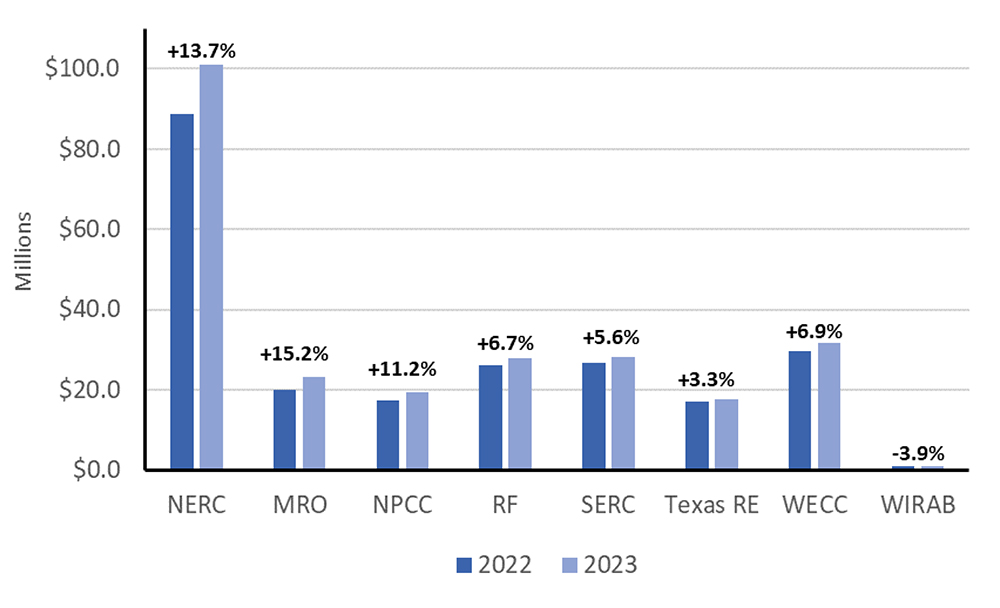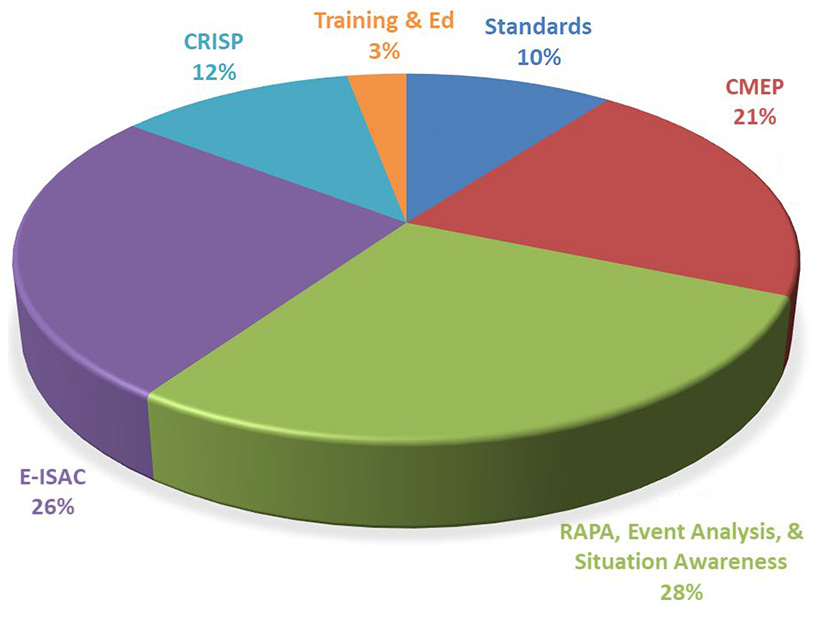Citing concerns about NERC’s accounting for costs related to the Electricity Information Sharing and Analysis Center (E-ISAC) in its 2023 Business Plan and Budget, FERC on Wednesday instructed the ERO to submit an array of additional information on the cost by early January (RR22-4).
The commission directed the additional compliance filing as part of its order accepting NERC’s budget, along with the business plans and budgets of the regional entities and the Western Interconnection Regional Advisory Board (WIRAB). NERC’s Board of Trustees approved the final budgets at its August meeting in Vancouver, following what board members called “the most comprehensive budget process” to date at the ERO. (See “Board Approves ERO Budgets,” NERC Board of Trustees/MRC Briefs: Aug. 17-18, 2022.)
Next year’s NERC budget is set to rise to $101 million, up 13.7% from last year. The total amount includes $38 million for the E-ISAC, including the Cyber Risk Information Sharing Program (CRISP), an increase of 15.8% from the 2022 budget. (See NERC FAC Approves Final 2023 ERO Budgets.) NERC’s assessment will also rise by 11.1% to $87.1 million.
Budgets, Assessments Up Across the Board
Budgets and assessments for the regional entities are set to increase as follows:
- Midwest Reliability Organization: $23 million budget, up 15% from last year; $20.5 million assessment, up 15%
- Northeast Power Coordinating Council: $20.4 million budget, up 11%; $18.1 million assessment, up 14%
- ReliabilityFirst: $28 million budget, up 6.7%; $24.6 million assessment, up 5%
- SERC Reliability: $28.2 million budget, up 5.6%; $26.2 million assessment, up 5.6%
- Texas Reliability Entity: $17.7 million budget, up 3.2%; $17.1 million assessment, up 14.2%
- WECC: $31.8 million budget, up 6.9%; $19.8 million assessment, down 21%
WIRAB’s 2023 budget is set to decrease by 3.9% next year to $883,520; its $681,920 assessment represents a 2.4% decrease from last year’s level.
FERC accepted all the budgets in its order, while also granting NERC’s request for a waiver of its Rules of Procedure (ROP) to allow it to use $1 million from its Assessment Stabilization Reserve (ASR) to offset its 2023 assessment.
NERC also requested a waiver of the ROP to allow MRO, NPCC, SERC and WECC to deposit penalty funds received between July 1, 2021 and June 30, 2022 — totaling $23.9 million — into their ASRs. FERC granted this request as well, along with approving WECC’s application to use $595,000 in funds gifted upon the dissolution of Peak Reliability in 2019 for two technology projects included in the RE’s business plan for next year.
E-ISAC Costs Require Follow-up
But the commission’s acquiescence came with strings attached in the form of the compliance filing that FERC demanded within 60 days of the order’s publication. Its direct inspiration is a comment submitted by the Edison Electric Institute in response to NERC’s original filing of the business plans and budgets.
EEI’s comment supported NERC’s budget overall; however, the size of the increase — NERC’s biggest budget hike since 2015 — spurred the organization to call for “a subsequent analysis to ensure the effectiveness of the expenditures.”
Specifically, EEI noted that a significant driver of the growth is the E-ISAC budget, which accounts for $5.1 million of the $12.2 million increase. The institute suggested that “all expenses associated with E-ISAC … should be detailed in separate line items,” and that electric industry stakeholders should also be given enough information to tell “whether other critical sectors are fully funding their participation” when they collaborate with the E-ISAC so that “electricity customers are not solely financially responsible for E-ISAC’s shared functions.”

FERC agreed that its oversight duties would be better served by “additional transparency into certain E-ISAC costs” and ordered NERC to provide information on several aspects of the program’s operations. In addition, the commission asked NERC for data on E-ISAC’s relation to outside partners and vendors.
First, FERC asked for “a detailed explanation of costs attributable to E-ISAC” in light of what it called insufficient transparency about how the ERO allocated direct and indirect costs to the program in the 2023 budget. As an example, the commission listed NERC’s new Business (Information) Technology department, which has a budget item labeled “E-ISAC” but does not specify “whether the technology costs relating specifically to E-ISAC are directly allocated to E-ISAC or whether NERC indirectly allocates these costs among all program areas.”
To address this alleged lack of clarity, FERC asked that NERC explain which of the new department’s costs, if any, are attributable to E-ISAC. If the department’s budget item does not attribute costs directly to E-ISAC, then NERC must explain “why these costs are more appropriately allocated as indirect costs to all statutory program areas.” The ERO must also explain its written policies and procedures that determine how costs are allocated.
FERC also pointed to NERC’s proposed $5.3 million expenditure for capital software investments, $4 million of which is to be funded by loan proceeds. According to NERC, the investments “span across [its] Statutory Program and Administrative Program departments” and represent several cost categories. The commission questioned the assignment of fixed asset costs and ordered the ERO to be clearer about how these funds are to be allocated, as well as its policy on assigning loan funds to program areas and a breakdown of how the $5.3 million are to be distributed.
Concerns over Collaboration Fairness
Along with questions about the direction of funds, the commission raised questions about the E-ISAC vendor affiliate program, a membership plan for suppliers of hardware and software products to the electricity sector. The program provides three levels of annual membership for vendors; higher levels cost more but confer additional benefits, such as access to networking sessions at the GridSecCon security conference or participation in GridSecCon panels.
FERC said it “is generally supportive of increased collaboration between E-ISAC members and the vendor community,” but said it is not clear how the tiered structure supports this goal while preventing participating vendors from engaging in sales and other “business development opportunities.” The commission directed NERC to explain why it chose this structure for the program, how it promotes collaboration and information sharing, and how the ERO provides oversight of the program to prevent business development.
Finally, FERC claimed that NERC’s budget was not sufficiently transparent regarding the division of costs in efforts involving collaboration with the natural gas sector. In particular, the commission focused on CRISP, the operational costs of which are split between program participants and assessment carried out under Section 215 of the Federal Power Act. FERC feared that because natural gas-only companies do not pay Section 215 assessments, they do not contribute to CRISP operations to the degree that their counterparts in the electric sector do.
While FERC acknowledged NERC’s claim that “the natural gas industry provides the funding to support their own collaboration,” the commission also pointed out that NERC has said elsewhere that “natural gas-only participants will also have access to other E-ISAC benefits, such as the E-ISAC portal.” FERC said this makes it unclear whether gas participants will pay for all or only some of their E-ISAC costs. The commission therefore directed NERC to explain what additional costs gas companies incur while participating in CRISP and E-ISAC, and how they fund those costs.
[Correction: An earlier version of this article included a mistaken reference to the location of the NERC board’s August meeting.]


